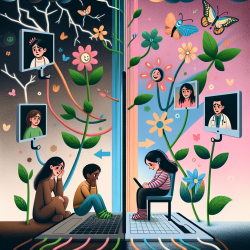In the dynamic landscape of occupational therapy, the winds of change are blowing stronger than ever, driven by the innovative sails of telehealth. As occupational therapists, our commitment to facilitating meaningful activities and promoting mental health has always been at the core of what we do. However, the path to achieving these goals is evolving, offering us an opportunity to self-actualize and redefine our roles within the therapy space. This evolution invites us to look at telehealth not just as a tool, but as a transformative approach that can enhance how we deliver care, especially within school settings.
For many of us, the idea of change, especially when it involves technology, can be daunting. Yet, embracing telehealth presents an opportunity to extend our reach and impact in ways we may have never imagined. Through online therapy services, such as those provided by TinyEYE, we can offer consistent, accessible care to students who might otherwise go without due to geographic, physical, or resource limitations. This shift towards telehealth does not diminish the value of traditional therapy; rather, it complements it by ensuring that no child is left behind due to logistical barriers.
The integration of telehealth into occupational therapy brings several benefits that align with our goal of supporting mental health and fostering self-actualization among our clients:
- Increased Accessibility: Telehealth removes physical barriers to therapy, making it easier for children in remote or underserved areas to receive the support they need.
- Flexibility: Online therapy services offer greater scheduling flexibility, allowing therapy sessions to be more easily integrated into a child's daily routine.
- Engagement: The digital format of telehealth can be particularly engaging for children, making use of interactive tools and games that enhance therapeutic outcomes.
- Parent Involvement: Telehealth facilitates easier participation of parents or guardians in the therapy process, fostering a more inclusive approach to care.
As occupational therapists looking for change, it's essential to acknowledge the role of telehealth in advancing our practice. By adopting this model, we not only stay at the forefront of our field but also ensure that our services are more inclusive and accessible. This shift requires us to develop new skills and adapt to digital platforms, but it also opens up a world of possibilities for professional growth and development.
At the heart of this transition is the understanding that our mission remains unchanged: to empower individuals to lead more fulfilling lives through meaningful occupation. Telehealth simply provides a new avenue to achieve this, allowing us to reach out to those who might otherwise be left out. In doing so, we not only contribute to the mental health and well-being of our clients but also embark on a journey of self-actualization as professionals, embracing the change that comes with technological advancement.
In conclusion, the integration of telehealth into occupational therapy is not just a trend but a meaningful shift towards a more accessible, flexible, and engaging form of care. As we navigate this transition, let us remain open to the possibilities it presents, both for our clients and for ourselves as therapists. By embracing telehealth, we are not just adapting to change; we are leading it, ensuring that our profession continues to thrive and make a difference in the lives of those we serve.










